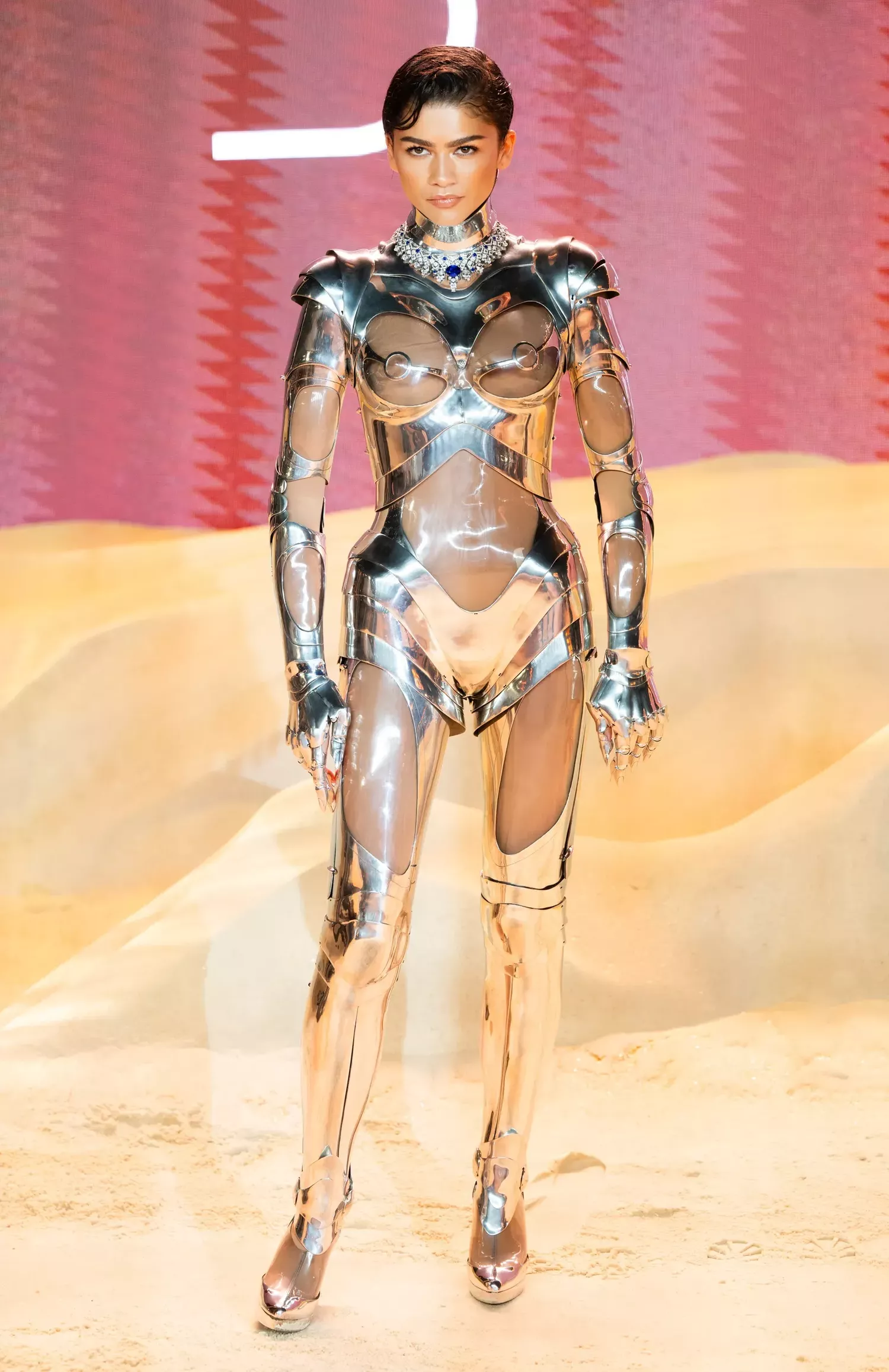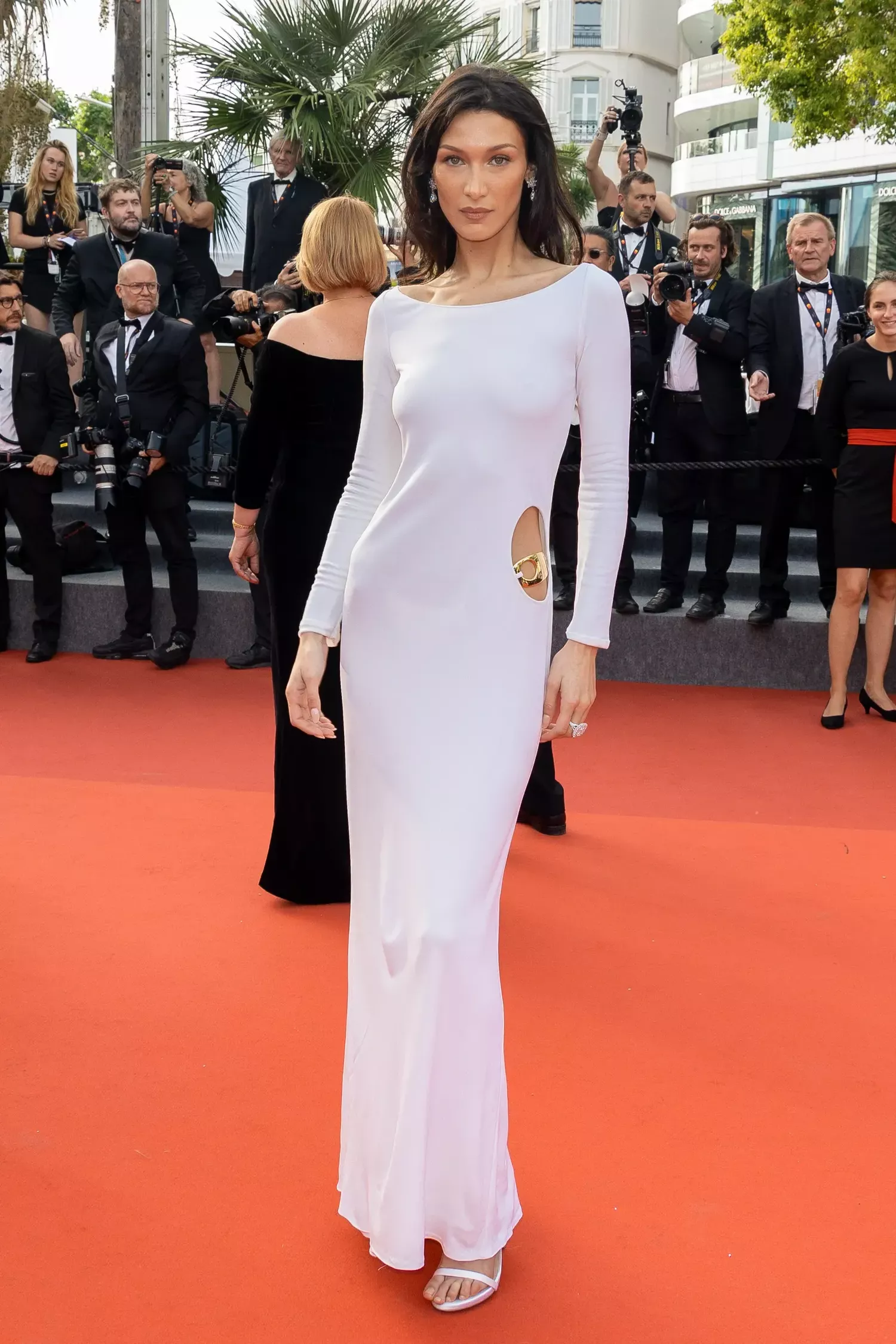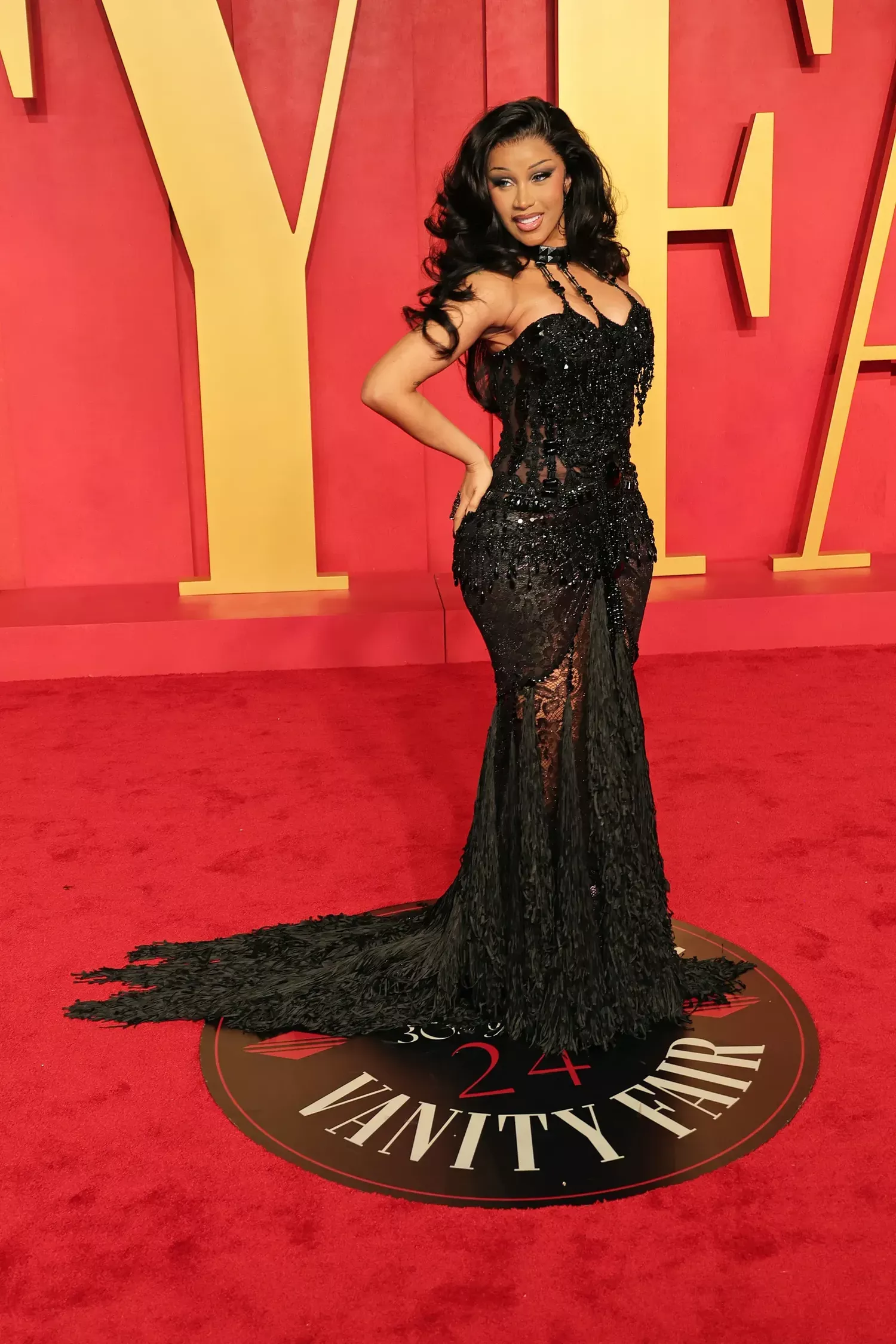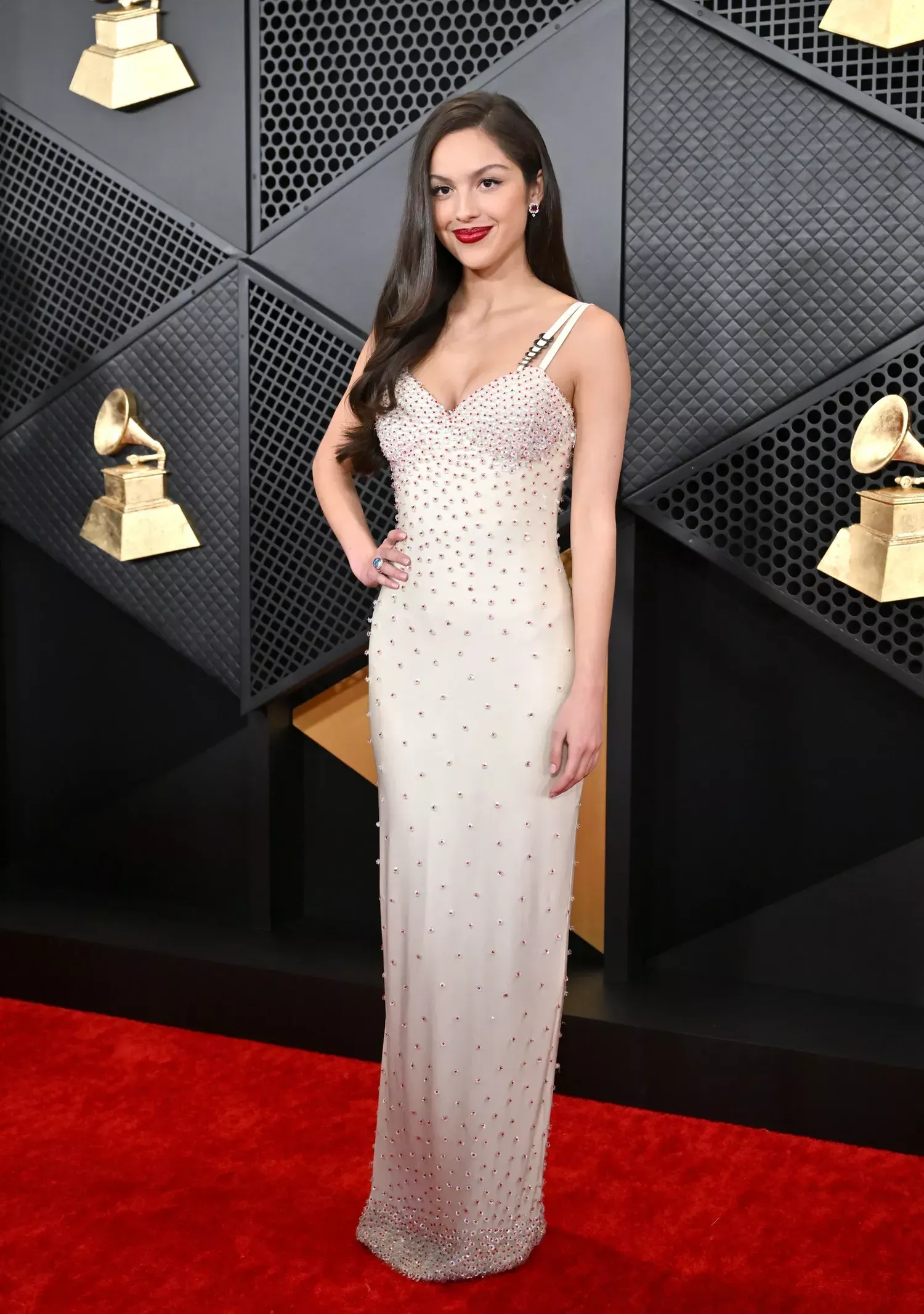Designer deep cuts became the most coveted celebrity flex this awards season. What do brands and stylists stand to gain?
As it often goes with Zendaya, the recent press tour for Dune: Part Two, in which she stars alongside Timothée Chalamet, Austin Butler and Florence Pugh, became just as much about the fashion as it was the film. Those who may have no idea who Princess Irulan is instantly clocked the grey suit Zendaya wore to the Seoul premiere of the film; designed by Lee McQueen for his autumn/winter '99 Givenchy collection, it was what the fashion commentariat have come to recognise as an insane pull.
Advertisement
The look was styled by Law Roach and sourced by Brynn Jones of the Los Angeles-based Aralda Vintage. It wasn’t Zendaya’s only major archive moment: she had just worn an autumn '95 Thierry Mugler robot suit (which I’m dubbing “Robo-Z”) as part of the same press tour.
Vintage has become a major red carpet trend. This past weekend at the Vanity Fair Oscars After Party, Jennifer Lawrence donned a vintage Givenchy look, this time by John Galliano, while Cardi B wore an Atelier Versace spring/summer '03 couture frock from Tab Vintage. Olivia Rodrigo wore vintage Versace to the Grammys, where Miley Cyrus performed in archival Bob Mackie, and Kylie Jenner donned the late Hanae Mori as Chalamet’s plus one to the Golden Globes. A few years back, vintage moments on the red carpet were far and few between — among the few examples was Bella Hadid in Gucci by Tom Ford at the Cannes Film Festival in 2022.

Zendaya wearing the autumn '95 Thierry Mugler robot suit at the 'Dune: Part Two' premiere in London in February. Photo: Samir Hussein/WireImage
What’s with all the throwbacks?
I recently wrote about the new wave of vintage hunters like Pechuga Vintage’s Johnny Valencia and Cherie Balch of Shrimpton Couture for the March issue of Vogue, outlining the way the vintage business has evolved from an insular market geared towards collectors and fanatics to an industry in its own right. What used to be fun, ‘if you know, you know’ fashion moments have transformed vintage into a fully fledged industry.
But when one of these looks is worn, the ROI is less clear than when a celebrity slips into a gown from a current runway. Who is the real winner here? Is it the celebrity, who gets a viral look; the stylist, who gets some well-deserved clout; the brand that is still attached to it, even if not directly responsible; or the – rarely credited – vintage dealer?
The business of archiving
“Vintage is the last unit of measurement of a flex for a stylist,” says Marco D’Angelo, founder and chief strategist at Platform PR, which counts Roberto Cavalli and Oscar de la Renta as clients, explaining that stylists now have to work their way up into pulling rare vintage from a brand’s archive. “First you get a sample, then custom, and then, if you’re lucky enough, the brand opens the archive.”
It used to be that celebrities would buy vintage looks when they could not get brands to dress them, but the business has changed, thanks largely to Roach. “We’ve been [pulling vintage] since Zendaya and I began working together, for 13 years now,” the image architect told my Vogue colleague Christian Allaire last month. “At first, it came out of necessity because back when we started, nobody would lend her clothes. And I come from vintage – I had a vintage store in Chicago – so a lot of the things that she wore were things from my store or vintage pieces.”
One could say that the celebrity is the number one winner here, but it’s often the brand that takes the bigger piece of the cake. What do brands stand to gain? There’s a detachment between an amazing archival pull and what’s currently being created by the house.
At Mugler, Casey Cadwallader will often riff off founder Thierry Mugler’s past pieces – think Beyoncé’s bee bodysuit for her Renaissance World Tour – but his own work stands apart in the sense that it’s more contemporary. These archival looks speak to the house in general but not necessarily to the current designer’s point of view. Givenchy doesn’t have a creative director at the moment, so the house can stand to get some positive archival clout, yet there is a disconnect when you think of Zendaya’s look and other Givenchy outfits worn during the Oscars weekend. Still, judging by earned media value, the looks draw attention. The Robo-Z look generated $13.3 million in media exposure for Mugler, according to Launchmetrics.

Bella Hadid in Gucci by Tom Ford at the Cannes Film Festival in 2022 . Photo: Marc Piasecki/FilmMagic
But the strategy, says D’Angelo, should be to look beyond brand awareness. Most brands with archives that go back to the ’80s are not necessarily in need of more name recognition, so the goal should be to translate the “moment” into a commercial opportunity. “In order for us to give you an archive piece, it needs to work seamlessly with what the current designer is doing,” says D’Angelo, “You want to mine the sense of nostalgia, but you want to make sure it doesn’t overhaul the current direction of the brand.”
After quite literally doing the robot on the red carpet, Zendaya changed into a black slip dress by Cadwallader from his Pre-Fall 2024 collection. It’s an even exchange: an archival look, for wearing a piece from the current collection by the current designer in return. “Sharing the spotlight between archives and the current season gives us the opportunity to celebrate Mugler’s past and future at the same time, allowing a new generation of fans and audiences to discover the brand from a new perspective,” shares a representative from Mugler.
Another option, says D’Angelo, is to reference the archival look in a current collection. “It’s complex and varies, but we advise that if it’s possible the archive moment is folded into a current collection, so it’s a full-circle message,” he says.
Back in February of 2022, Cardi B was looking to wear an archival Cavalli piece from 2002. The archive pull didn’t work out, so designer Fausto Puglisi offered a custom dress based on the piece. The patchwork leather design, a Cavalli signature, was a focus in the collection he presented a few weeks after.
These moments will help a brand remind the audience of its storied past: “Archive loans are intentionally rare and remain exceptional,” shares a Mugler rep, explaining that it has opened its archives on this occasion to kick off the 50-year anniversary since Mr Mugler founded the house. Apart from Zendaya, they have recently worked with Margot Robbie and her stylist Andrew Mukamal on the archive look she wore to the Vanity Fair Oscars Party.
But this also allows for current designers to preserve brand integrity through continuity. Think of Daniel Roseberry at Schiaparelli, or Demna at Balenciaga working with stylist Mukamal to reinterpret archival looks for Carey Mulligan this awards season. This also helps keep the current designer in the conversation — what you don’t want is the vintage look to prompt conversation about how things “used to be better”. Needless to say, there’s more than enough of that kind of nostalgia out there at the moment.

Cardi B wore an Atelier Versace SS03 couture frock from Tab Vintage at the Vanity Fair Oscars After Party on Sunday. Photo: Kayla Oaddams/FilmMagic
But what if the brand isn’t the architect behind the moment? Not every house has an archive as well-maintained as Mugler’s, meaning they can’t always lend pieces. This is where vintage dealers come in. Samantha McMillen dressed Elle Fanning in vintage couture from Cherie Balch’s Shrimpton Couture based in Canada; the aforementioned Givenchy skirt suit worn by Zendaya was sourced from LA’s Aralda Vintage.
On the brand side, comms can be tricky. They can take ownership of the moment and leverage the attention — the way Givenchy did by sending out a press blast about Zendaya – but narrative control is key. “When people want vintage, they’re going to get it even when you say no,” says D’Angelo. “You want to control the message and make sure that the celebrity is a fit, but you still benefit from the attention.” Still, even when the brand benefits from the attention, D’Angelo does not send a press blast unless the look comes from them. “If someone comes back with a question, you don’t really have much to say,” he explains.
To lend or not to lend?
Jones founded Aralda Vintage almost a decade ago, and opened up shop in Los Angeles in 2017. Jones and her small team have become the hands behind some of the buzziest vintage looks on celebrities as of late: Zendaya’s Givenchy look; Ariana Grande’s Dolce & Gabbana floral boots and skirt for her most-recent album promo; the Jean Paul Gaultier frock that Alexa Demie recently wore on stage with Madonna.
Jones and businesses like Aralda Vintage are – crucial as they may be in allowing moments like Zendaya’s Givenchy to happen – often the ones who stand to gain the least in the archival economy. It all hinges on credits, whether from stylists, celebrities or the publications who write about these moments.
Jones used to loan out her rare and collectable pieces but learnt quickly that it doesn’t pay the bills and rarely provides solid ROI (especially when credits aren’t guaranteed). “There’s a sticky line with understanding when someone should give you credit if you loan,” explains Jones, who, after trying rentals for some time, decided to move to a purchase-only model with stylists. “If they’re paying, they can credit or not. They own it, and I’ve been paid for it, so I’m good.” Keep your money where you can see it, they say.
Still, credit is key in translating a viral celebrity moment into a commercial opportunity. It’s an “if a tree falls in a forest and no one is around to hear it” situation – if Kendall Jenner wears a vintage Mugler suit from Aralda, which she did last week, and no one registers it came from Jones, does it make any difference to her business? “I used to not post celebrity placements because it felt too clouty, but I realised it was silly not to,” she says. “They bring a lot of traffic to the page when we post them, because the people who want to know, know to find it,” says Jones of the fervent fashion fans who will look into who wore what to share it online. The benefit of proper attribution? “It brings people to the account and also to the store.”

Olivia Rodrigo wore vintage Versace to the Grammys in February. Photo: Axelle/Bauer-Griffin/FilmMagic
The content gymnastics
The less discussed but just as important aspect of this is the content. Savvy stylists like Roach or McMillen know that that part of the buzz around the vintage look comes from people knowing it is a vintage look. Does it matter that Robbie wore a vintage Mugler look to the Vanity Fair party if we don’t know the look’s provenance?
Nowadays, the success of a vintage piece – or its reiteration, like Mulligan’s Balenciaga – hinges on whether or not it gets clocked online by fashion fanatics. These are the folks who make a moment like Robo-Z go viral because they give the look context and, therefore, gravitas. The older and rarer, the better. The deeper the cut, the more viral. This is also why Miley Cyrus and her stylist, Bradley Kenneth, have been making headlines for her looks.
The internet has become an important player: accounts like @ChecktheTag on Instagram spot the archive and post the credit. Wearing a look off the runway is a flex, but unearthing a one-of-a-kind look from decades ago simply hits different, especially now that archival fashion imagery is deeply embedded in pop culture. Side-by-side content of a celebrity and the archival counterpart also performs incredibly well – Caroline Polachek at the Grammys wearing Olivier Theyskens’s autumn/winter '98 next to the look on the runway lit up on social. It was styled by Kat Typaldos.
For now, vintage pulls show no sign of dying down, meaning there’s more opportunity for those involved to make the most of the moment. “Sometimes it feels like we’re not even eating from the same cake,” says Jones. The takeaway? Don’t battle for a slice; bake your own cake.
Originally published on Vogue Business.
